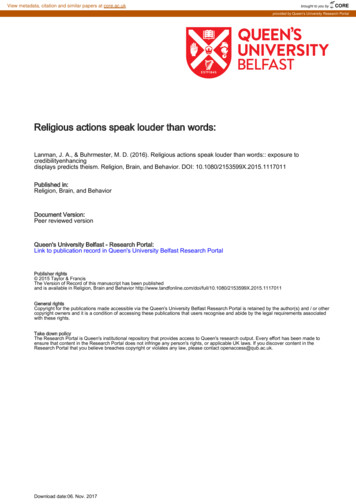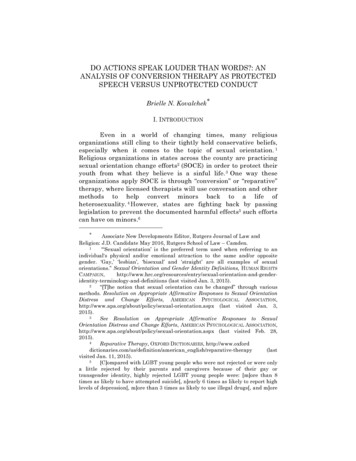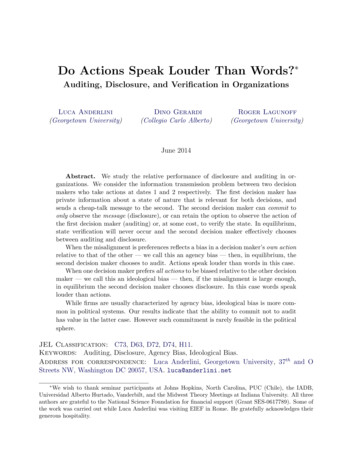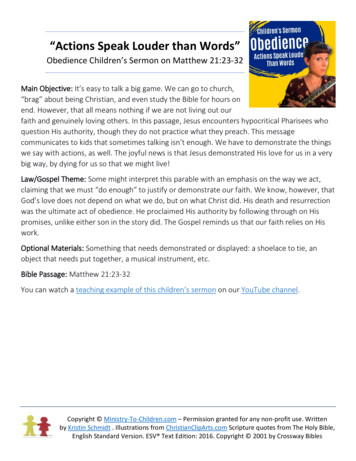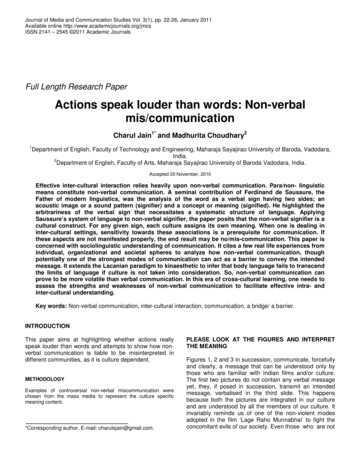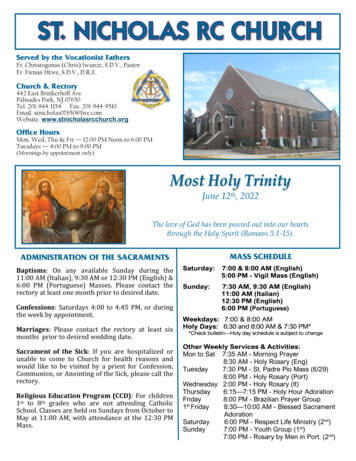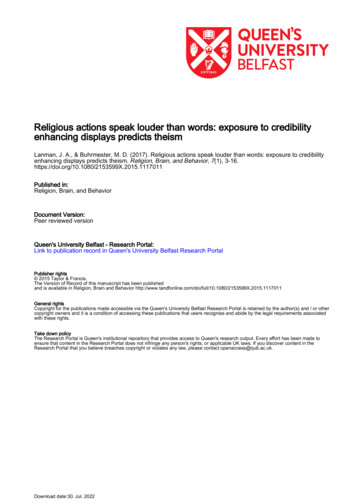
Transcription
Religious actions speak louder than words: exposure to credibilityenhancing displays predicts theismLanman, J. A., & Buhrmester, M. D. (2017). Religious actions speak louder than words: exposure to credibilityenhancing displays predicts theism. Religion, Brain, and Behavior, 7(1), Published in:Religion, Brain, and BehaviorDocument Version:Peer reviewed versionQueen's University Belfast - Research Portal:Link to publication record in Queen's University Belfast Research PortalPublisher rights 2015 Taylor & Francis.The Version of Record of this manuscript has been publishedand is available in Religion, Brain and Behavior 9X.2015.1117011General rightsCopyright for the publications made accessible via the Queen's University Belfast Research Portal is retained by the author(s) and / or othercopyright owners and it is a condition of accessing these publications that users recognise and abide by the legal requirements associatedwith these rights.Take down policyThe Research Portal is Queen's institutional repository that provides access to Queen's research output. Every effort has been made toensure that content in the Research Portal does not infringe any person's rights, or applicable UK laws. If you discover content in theResearch Portal that you believe breaches copyright or violates any law, please contact openaccess@qub.ac.uk.Download date:30. Jul. 2022
Unedited draft: In press in Religion, Brain, and Behavior1Religious Actions Speak Louder than Words:Exposure to Credibility Enhancing Displays Predicts TheismJonathan A. Lanman 1Michael D. Buhrmester 1,21Institute of Cognition and Culture, Queen’s University, Belfast, 2-4 Fitzwilliam St, BelfastBT7 1NN, UK2Institute of Cognitive and Evolutionary Anthropology, University of Oxford, 64 BanburyRoad, Oxford OX2 6PN, UKCORRESPONDING AUTHOR:Dr. Jonathan A. Lanman, Institute of Cognition and Culture, Queen’s University, Belfast, 2-4Fitzwilliam St, Belfast BT7 1NN, UK, j.lanman@qub.ac.uk, phone: 44 (0) 28 9097 1173ACKNOWLEDGEMENTS:The work of both authors on this paper was supported by a Large Grant from the UK’sEconomic and Social Research Council (REF RES-060-25-0085) entitled “Ritual, Community,and Conflict” and an award from the John Templeton Foundation entitled “Religion’s Impact onHuman Life” (#37624). Ideas expressed in this publication are those of the authors and do notnecessarily reflect the views of these granting agencies. The authors would like to thank RichardSosis, Aiyana Willard, and 3 anonymous reviewers for their helpful comments on the
Unedited draft: In press in Religion, Brain, and Behavior2manuscript. The authors declare no potential conflicts of interests with respect to the authorshipand/or publication of this article.Abstract:One of the central aims of the cognitive science of religion (CSR) is to explain why supernaturalagent beliefs are so widespread. A related but distinct aim is to explain why some individualshold supernatural agent beliefs but others do not. Here, we aim to provide an initial test of thepower of exposure to what Henrich calls “credibility enhancing displays” (or “CREDs”) indetermining whether or not an individual holds explicit supernatural agent beliefs. We presentevidence from two studies of Americans suggesting that exposure to CREDs, as measured by ascale we developed and validated, predicts current theism vs. non-theism, certainty of God’sexistence/non-existence, and religiosity while controlling for overall religious socialization.These results are among the first to empirically support the theorized significance of CREDs forthe acquisition of supernatural agent beliefs.Keywords: cognitive science of religion, credibility enhancing displays, CREDs, religioussocialization, religious emphasis, theism, atheism, non-theism
Unedited draft: In press in Religion, Brain, and Behavior3Religious Actions Speak Louder than Words:Exposure to Credibility Enhancing Displays Predicts TheismIntroductionOne of the central aims of the cognitive and evolutionary study of religion is to explainthe widespread presence of supernatural agent beliefs across cultures and history. Cognitive andevolutionary scholars of religion have offered a variety of explanations for this ubiquity. Some(e.g. Atran, 2002; Barrett, 2004; Boyer, 2001; Pyysiäinen, 2009) argue that a variety of panhuman cognitive biases and tendencies work to make supernatural agent beliefs both memorableand believable, consequently leading to their cultural success. Others (e.g. Bering, 2006; 2010;Johnson, 2005) argue that an implicit belief in some form of supernatural agency is an evolvedfeature of human psychology that works to prevent reputation-damaging behavior. Still others(e.g. Irons, 2001; Purzycki & Sosis, 2009; Sosis & Bulbulia, 2011; Sosis & Kiper, 2014) arguethat supernatural agent beliefs are components of adaptive religious systems that evolve to helphuman communities overcome the problem of cooperation.None of the mechanisms hypothesized as explaining the ubiquity of such beliefs,however, deterministically produce explicit supernatural agent beliefs in all minds (Geertz &Markússon, 2010; Norris & Inglehart, 2004; Zuckerman, 2007), raising the question of whysome individuals possess supernatural agent beliefs but others do not. This question hasattracted less attention, but interest is growing (Gervais & Najle, in press; Lanman, 2013;Norenzayan & Gervais, 2013). Gervais and Norenzayan (2012), for instance, find that individualdifferences in analytical thinking predict religious disbelief. Further, Norenzayan, Gervais, and
Unedited draft: In press in Religion, Brain, and Behavior4Trzesniewski (2012), find mentalizing ability as significant in predicting high vs. low religiousbelief. Similarly, Willard and Norenzayan (2013), find mentalizing ability a significant predictorof belief in God through the mediating factors of mind-body dualism (Bloom, 2004) andteleological reasoning (Kelemen, 2004).Willard and Norenzayan note, however, that social learning also likely influences levelsof supernatural agent belief, and find among an adult sample of Americans that the percentage ofchurch attenders in an individual’s county significantly predicts their levels of belief in God.And indeed, socialization is one of the most well-founded explanations of why some individualscome to believe in supernatural agents and others do not (Beit-Hallahmi, 2015; Gervais & Najle,in press). Work in both the psychology and sociology of religion suggests that socialization, mostnotably by parents, has a significant impact not only on which supernatural agents children growup to believe in, but whether they believe in such agents at all (Albrecht, Cornwall, &Cunningham, 1988; Baker & Smith, 2009; Dudley, 1978; 1999; Flor & Knapp, 2001; Hood, Hill,& Spilka, 2009; Hunsberger, 1980; 1983; Hunsberger & Altemeyer, 2006; Hunsberger & Brown,1984; Ozorak, 1989; Sherkat, 1991; Wilson & Sherkat, 1994). This social learning account ofreligious affiliation and theism follows a long tradition in social psychology stressing the role ofmodels in the transmission of representations and behaviours (Bandura, 1971; 1986; Hovland &Weiss, 1951).Social learning and cognitive biases need not be seen as conflicting explanations for atleast two reasons. First, it is possible that both factors independently explain variance insupernatural agent beliefs. Second, some relevant cognitive biases may have evolved precisely toallow human beings to better benefit from social learning (Henrich & McElreath, 2003;
Unedited draft: In press in Religion, Brain, and Behavior5Richerson & Boyd, 2005). Examples of proposed biases in social learning include a prestigebias, which biases learners towards accepting information from individuals with high levels ofsocial prestige (Henrich & Gil-White, 2001), and a conformist bias, which biases learnerstowards accepting the most common beliefs, attitudes, and practices within their ingroups(Henrich & Boyd, 1998).Credibility Enhancing Displays (CREDs)In 2009, Henrich made a prima facie case for the existence of an additional sociallearning bias with significant implications for explaining why some individuals come to believein the existence of supernatural agents and others do not. This bias is to accept information, suchas information about the existence of supernatural agents, expressed verbally by cultural modelsto the extent that these verbalizations are accompanied by “credibility enhancing displays” or“CREDs” (2009). These are, according to Henrich, “displays by a model that would seem costlyto the model if he or she held beliefs different from those he or she expresses verbally” (2009,p.244). CREDs need not have an actual net fitness cost to affect cultural learning (e.g. eatingblue mushrooms after verbally claiming their lack of toxicity is a CRED for the claim but is notcostly) and concern the transmission of beliefs rather than the signaling of commitment to agroup, distinguishing CREDs from costly signals. To say we have a CREDs bias, then, is to saythat we have a bias to believe particular pronouncements from cultural models to the extent thatthey “walk the walk” and not just “talk the talk” in relation to those pronouncements.Henrich offers both an evolutionary rationale for the development of this bias andevidence from a variety of sub-fields of psychology of its existence. Henrich argues that a newtype of deception emerged with the evolution of language, such that manipulative individuals
Unedited draft: In press in Religion, Brain, and Behavior6could express an idea cheaply through speech that, if believed by learners, would benefit themanipulator at a cost to the learners. In this novel environment, a selection pressure would existfor any cognitive mechanism that would help cultural learners reject deceptive and manipulativeinformation. Henrich proposes that natural selection responded by “constructing a kind ofcultural immune system [ ] designed to assess a potential model’s degree of belief orcommitment to a symbolically communicated belief using the models’ displays or actions”(2009, p. 247). Henrich’s claim fits well with the long-standing literature in social anddevelopmental psychology, which shows behavioral modelling to be more effective intransmitting attitudes and behaviors than verbal modelling (Eagley, Wood, & Chaiken, 1978;Fisher, Fisher, Bryan, & Misovich, 2002; Harper & Sanders, 1975; Harris & Koenig, 2006;Harris, Pasquini, Duke, Asscher, & Pons, 2006; Walster, Aronson, & Abrahams, 1966). To date,however, little empirical work has directly examined the effects of exposure to CREDs onreligious transmission (Lanman, 2012).Henrich argues that the existence of a CREDs bias allows for the cultural evolution ofstable sets of costly practices and the linking of these practices to group-beneficial ideologies,and models by both Henrich (2009) and by Wildman & Sosis (2011) support this claim. Ourargument, however, concerns an additional implication of a CREDs bias. More specifically, aCREDs bias may have significant implications for explaining why some individuals come tobelieve in the existence of supernatural agents and others do not. In fact, the CREDs bias may beparticularly relevant for supernatural agent beliefs, which are not easily confirmed ordisconfirmed by direct experience or intuition and are especially reliant on testimony, andpotentially CREDs, for their cultural success.
Unedited draft: In press in Religion, Brain, and Behavior7A key implication of the CREDs bias for supernatural agent beliefs is that not allreligious socialization is created equal. Religious socialization involves both verbalizations (e.g.telling learners that supernatural agents exist, describing their interests and behaviors, instructinglearners of how they should interact with such agents, etc.) as well as actions that we may labelas CREDs (e.g. following moral, dietary, and sartorial norms established and/or endorsed by saidsupernatural agents; attempting communication with said agents, and attending collectivegatherings devoted to said agents). Our analysis of CREDs suggests that religious socializers willbe especially effective at transmitting beliefs in supernatural agents if they perform CREDs fortheir stated beliefs. Conversely, verbal assertions of the existence and importance of supernaturalagents without appropriate CREDs should be less effective.A consistent but quite limited body of evidence concerning religious commitment andbelief in the Western monotheistic God supports our hypotheses. For example, Roger Dudley’slongitudinal study of 7th Day Adventists found that a key predictor of whether an individualremained in the 7th Day Adventist Church as an adult was exposure to parental church attendanceand the frequency of their worshipping together as a family (1978; 1999). Similarly, Bader &Desmond (2006) found that parents exhibiting greater consistency between the importance theyattached to religion and their actual church attendance were more successful in producing higherlevels of religiosity in their children. And more recently, Bengston, Putney, & Harris (2013)analysed a large (N 3500) qualitative sample of Americans and repeatedly stressed the role ofperceived religious hypocrisy in apostasy.In relation to theism and non-theism specifically, Hunsberger & Altemeyer (2006) foundsignificant differences between samples of theists and atheists on a measure of the “religious
Unedited draft: In press in Religion, Brain, and Behavior8emphasis” shown by parents and other important figures. Similarly, in an international but nonrandom sample Lanman (2012) found that theists reported more religious CREDs exposureduring their upbringing than non-theists.Overall, the empirical literature supporting the role of CREDs in the transmission oftheism is suggestive but far from conclusive. First, the dependent measures in question havemore often been religious affiliation with the specific religious traditions of one’s parents thantheistic belief. Second, past studies have not clearly separated the effects of verbalizations andCREDs. For instance, many of the items in Hunsberger & Altemeyer’s religious emphasis scalecover both verbalizations and CREDs (e.g., to what extent did the important people in your lifeemphasize: “making religion the center, the most important part of your life,” [p.43]), Similarly,Bader & Desmond (2006) sometimes interpret the ‘importance’ parents attach to religion asindicating verbalizations (verbally emphasizing how important religion is) and sometimes aslikely CRED-related (“permeating life within the household” [p.319]). And while Lanman(2012) did focus on theism and non-theism specifically and did isolate CREDs from generalreligious socialization, he did not produce a validated CREDs exposure measure and onlydocumented a significant difference between theists and non-theists, rather than establishing thepredictive power of CREDs on theism.A remaining question from this literature is the extent to which being exposed to religiousCREDs predicts whether or not an individual becomes a theist or non-theist. Is it really “walkingthe walk” that facilitates the transmission of theism, as the CREDs hypothesis predicts, or isCREDs exposure simply another way of speaking about the long-studied general process ofreligious socialization?
Unedited draft: In press in Religion, Brain, and Behavior9The Present StudiesTo better ascertain the importance of exposure to religious CREDs for explaining theismand non-theism, we set out to 1) develop and validate a CREDs Exposure Scale and 2) test itspredictive power for theistic belief and religious identity while controlling for the effects ofoverall religious socialization.Study 1In our first study, we surveyed a sample of Americans to test two hypotheses. First, wepredicted that CREDs exposure is a distinct construct, irreducible to more general constructs ofreligious socialization and demographics (Hypothesis 1). Second, we predicted that CREDsexposure is an important predictor of both dichotomous (theism vs. non-theism) and continuous(belief certainty) measures of theistic belief, even while controlling for effects of overallreligious socialization (Hypothesis 2).MethodsSample. Two hundred and sixteen Americans (63% Females; mean age 37.3 years; SD 13.7; age range from 18 to 75 years; 82% Caucasian) participated online via Amazon’sMechanical Turk (for evaluations of Mechanical Turk’s suitability for social science research,see Buhrmester, Kwang, & Gosling, 2011; Horton, Rand, & Zeckhauser, 2011; Mason & Suri,2012; Paolacci, Chandler, & Ipeirotis, 2010) in return for a small amount of monetarycompensationi. Participants’ current religious affiliation was as follows: 46% non-religious, 29%Protestant denominations, 17% Catholic, 2% Jewish, .5% Muslim, 2% Buddhist, 3.5%other/unspecifiedii. Participants read that the survey concerned their ‘thoughts and experiences
Unedited draft: In press in Religion, Brain, and Behavior10regarding religion,’ provided informed consent, then completed the following battery of scales inthe order presented.Measures.CREDs Exposure. We initially generated ten items based on Henrich (2009) andexploratory survey work conducted by Lanman (2012). On seven point Likert scales (i.e., ‘to noextent at all’ ‘to an extreme extent’), participants rated the extent to which they observed theircaregivers engage in behavioral modeling of religion during their upbringings (e.g., ‘To whatextent did your caregiver(s) attend religious services or meetings?’; see Appendix for the scale)iii.Religious Emphasis. As a measure of overall religious socialization, we used Hunsberger& Altemeyer’s (2006) twenty-item measure of religious emphasis. On seven point Likert scales,participants rated the extent to which important people in their lives emphasized variousreligious actions and beliefs during their upbringing (e.g., To what extent did they tell you to“make religion the center, the most important part of your life?” and “discuss moral do’s anddon’ts in religious terms?”; α .98).Outcome measures. To assess belief in God, participants answered yes or no to thequestion ‘Do you currently believe that God exists?’ (66% of participants responded ‘yes’). Toassess certainty of God belief, on a seven-point Likert scale (1 extremely certain God does notexist, 7 extremely certain God exists) participants answered the question ‘How certain are youabout the existence of God?’ (M 4.56, SD 2.29). Finally, all participants completed a set ofdemographic questions (age, gender, ethnicity, household income, religious affiliation, caregiverstatus during upbringing) and were debriefed.Results
Unedited draft: In press in Religion, Brain, and Behavior11Preliminary analyses. To examine the internal structure of the ten initial CREDs itemsand explore dimension reduction, we conducted a principle component analysis (Jolliffe, 2002).Two components emerged, with component one accounting for 54.9% of the variance(eigenvalue 5.49), and the second component accounting for 13.8% (eigenvalue 1.38).Inspection of the scree plot also indicated two components. The three items that made up thesecond component concerned highly specific types of displays (i.e., sticking to religiouslyprescribed food choices, clothing styles, and fasting rituals). In addition, means to these threeitems were relatively lower (less than M 2.1) compared to the other seven items (range M 2.5to 3.9). Given our goal to produce a short scale that could apply across a range of religioustraditions, which vary considerably in their dietary and sartorial norms, we decided these itemsdid not fit the scale’s intent and removed them from the scale. The remaining seven items hadhigh internal consistency, α .92, with scale M 3.27 and SD 1.51. Corrected item-totalcorrelations ranged from .71 to .81. See Table 1 for a summary of scale characteristics and Table2 for inter-item correlations and item means and standard deviations.With our seven-item CREDs exposure scale in hand, we examined its relationship withHunsberger & Altemeyer’s (2006) religious emphasis scale (see Table 3 for a summary). Asexpected, CREDs was moderately correlated with religious emphasis, r (214) .56, p .001. Toexplore the factor structure of the CREDs scale in relation to the religious emphasis scale, weconducted an exploratory factor analysis (maximum likelihood extraction with direct obliminrotation). Two factors emerged, with one factor (all 20 emphasis items) accounting for 58.04%of the variance (eigenvalue 15.67) and a second factor (all seven CREDs items) accounting for11.35% of the variance (eigenvalue 3.07). Factors were moderately correlated, r .51.
Unedited draft: In press in Religion, Brain, and Behavior12Inspection of the scree plot also indicated two factors. Together, these results suggest that ourCREDs exposure scale and the religious emphasis scale represent related but distinct constructs.We also explored CREDs’ relationship with demographic variables (i.e., age, gender,ethnicity, and household income) and caregiver type during upbringing (i.e., singleparent/guardian, two cohabiting parents/guardians, two divorced/separated parents/guardians,more than two parents/guardians, other). The CREDs scale was not associated with any of thesevariables, r ’s .05, F’s 1.5, p’s .20. In addition, demographic variables were largelyunrelated to the outcome measures (i.e., belief in God, certainty of belief in God), r ’s .14, F’s 1.9, p’s .12, except for age which was weakly associated with belief in God, r (213) .21, p .01, and certainty of belief in God, r (213) .20, p .01. In addition, ethnicity was related tobelief in God, Pearson χ2 (4) 15.23, p .01, and certainty of belief in God, F (4, 209) 4.18, p .01, indicating that African-American participants were especially likely to believe that Godexists and report high certainty. In preliminary regression analyses that controlled for age andethnicity in the models presented below, age and ethnicity did not significantly change thepattern of effects; consequently they were dropped from models reported here.Regression analyses. To test the hypothesis that CREDs exposure predicts belief in God(dichotomous) beyond the effect of religious emphasis, we conducted two logistic regressions. Inthe first, religious emphasis was entered as a predictor of belief in God. Emphasis predictedbelief in God, unstandardized b .22, SE of b .09, Wald χ2 (1) 6.58, p .01, OR 1.25, 95%CI of OR: 1.05, 1.48. In the second, CREDs was added as a second predictor in the same model.Consistent with our hypothesis, CREDs predicted belief in God, unstandardized b .52, SE of b .13, Wald χ2 (1) 14.94, p .001, OR 1.68, 95% CI of OR: 1.29, 2.18, whereas religious
Unedited draft: In press in Religion, Brain, and Behavior13emphasis did not, b -.01, SE of b .11, Wald χ2 (1) .01, n.s. (see Table 4 for a summary).The predicted probability for persons with low CREDs exposure (-1SD) to report believing inGod was 50%. In contrast, the predicted probability for persons with high CREDs exposure( 1SD) to report believing in God was 82%.Next, using linear regressions we followed the same two-step procedure with regard tothe certainty of God belief outcome. In the first regression, emphasis predicted belief certainty, b .21, SE of b .09, 95% CI of b: .04, .39, t (214) 2.44, p .02. Adding CREDs as a predictorto the model, CREDs predicted belief certainty, b .39, SE of b .12, 95% CI of b: .15, .63, t(213) 3.24, p .001, whereas emphasis did not, b .03, SE of b .10, 95% CI of b: -.18, .23, t(213) .27, n.s.Participants indicated their caregivers’ religious affiliation during their upbringing whichwe coded dichotomously (90% had religious caregivers; 10% had non-religious caregivers). Totest whether the pattern of effects reported above were similar amongst participants raised withreligious caregivers, we excluded participants with non-religious caregivers from the dataset andre-ran the analyses above. The results were very similar. CREDs predicted belief in God, b .54,SE of b .14, Wald χ2 (1) 13.71, p .001, OR 1.71, 95% CI of OR: 1.29, 2.27, whereasreligious emphasis did not, b -.05, SE of b .11, Wald χ2 (1) .17, n.s. CREDs also predictedcertainty of belief in God, b .37, SE of b .13, 95% CI of b: .12, .62, t (191) 2.90, p .01,whereas emphasis did not, b -.02, SE of b .11, 95% CI of b: -.23, .19, t (191) -.20, n.s.These results suggest that the effects of CREDs do not merely reflect a tendency for nonreligious caregivers to raise non-religious children and religious caregivers to raise religious
Unedited draft: In press in Religion, Brain, and Behavior14children. Rather, they suggest that the behavioral modeling of religious caregivers has asignificant impact on whether or not they successfully transmit theistic beliefs to their children.DiscussionThe results of Study 1 supported both of our hypotheses. In support of Hypothesis 1, ourseven-item CREDs exposure measure demonstrated high internal consistency and discriminantvalidity. In support of Hypothesis 2, CREDs exposure predicted both dichotomous andcontinuous measures of theistic belief. While religious emphasis was associated with God beliefand belief certainty on its own, our results suggest that this is due to shared variance with ourCREDs exposure scale. When including the CREDs exposure scale in each model, CREDs wasstrongly predictive of both outcomes whereas religious emphasis was not. Controlling forreligious emphasis, participants who reported relatively high levels of CREDs exposure wereespecially likely to report believing in God and feeling especially certain in their theistic belief.Conversely, participants who reported relatively low levels of CREDs exposure were especiallylikely to report not believing in God and feeling especially certain in their atheistic belief.Encouraged by these findings, we sought to replicate them in a new sample as well as rule out analternative hypothesis.Study 2In Study 2, we aimed to replicate the results from Study 1 with a new sample using onlythe final seven-item CREDs exposure scale and to test two additional hypotheses derived fromlingering questions. First, would CREDs exposure also predict religiosity? There is a relevantdistinction between theism and religiosity, as many theists do not see themselves as belonging toa particular religious tradition. Nevertheless, theistic CREDs, we argue, do not merely attest to
Unedited draft: In press in Religion, Brain, and Behavior15theism but to the theistic cultural traditions professed by models (Cohen, 2009; Johnson, Hill, &Cohen, 2011). Consequently, as Hypothesis 3, we predicted that our CREDs exposure measurewould predict both dichotomous and continuous measures of religious identity.Second, might the effects of CREDs exposure be explained by a third variable – namelyone’s own religious practice during one’s upbringing? It could be argued that one’s responses onthe CREDs exposure measure merely reflect one’s own religious actions during one’supbringing. In line with a cognitive dissonance account (Festinger, 1957), reflecting on one’sown religious practices may serve to solidify one’s religious belief irrespective of CREDsexposure. We would argue that, should such an effect exist, it is not responsible for the effect ofCREDs on theism and religiosity. Thus, we predicted that the influence of CREDs exposure onbelief and religiosity measures would hold while controlling not only for religious emphasis butalso for one’s own previous religious practice (Hypothesis 4).MethodsSample. One hundred Americans participated online via Mechanical Turk (56% females;mean age 36.1 years; SD 13.1; age range from 18 to 73 years; 80% Caucasian; 44% nonreligious, 36% Protestant denominations, 16% Catholic, 2% Jewish, 1% Hindu, 1% Sikh).General participation procedure was the same as Study 1.Measures. Participants first completed the seven-item CREDs exposure scale followedby the religious emphasis scale. As in Study 1, participants then completed two questions toassess their current belief in the existence of God (68% believed in God) and the certainty ofGod belief (M 4.59, SD 2.3). In addition, participants were asked whether or not theycurrently followed a religion (56% responded ‘yes’), the extent to which they themselves
Unedited draft: In press in Religion, Brain, and Behavior16practiced religion during their upbringing (M 3.76, SD 1.74), and Shariff, Cohen, andNorenzayan’s (2008) six self-reported religiosity items on five-point Likert scales (e.g., ‘Myreligion or faith is an important part of my identity’; α .94, M 2.88, SD 1.27). Last,participants completed demographic questions (age, gender, ethnicity, religious affiliation,caregiver status during upbringing) and were debriefed.ResultsPreliminary Analyses. As in Study 1, CREDs exposure was not associated withdemographic variables (i.e., age, gender, ethnicity, household income, and caregiver type duringupbringing), r’s .10, F’s .95, p’s .28. In addition, demographic variables were not relatedto primary outcome measures (i.e., belief in God, certainty of belief in God, religiosity), r ’s .14, F’s 1.9, p’s .12. Lastly, we conducted a factor analysis of the religious emphasis andCREDs items parallel to Study 1. The results replicated those in Study 1, with the religiousemphasis items loading on one factor (60.04% of the variance; eigenvalue 16.21) and theCREDs items on a separate second factor (11.32% of the variance; eigenvalue 6.06).Regression Analyses. We then conducted regression analyses parallel to
Religious Actions Speak Louder than Words: Exposure to Credibility Enhancing Displays Predicts Theism Introduction One of the central aims of the cognitive and evolutionary study of religion is to explain the widespread presence of supernatural agent beliefs across cultures and history. Cognitive and
